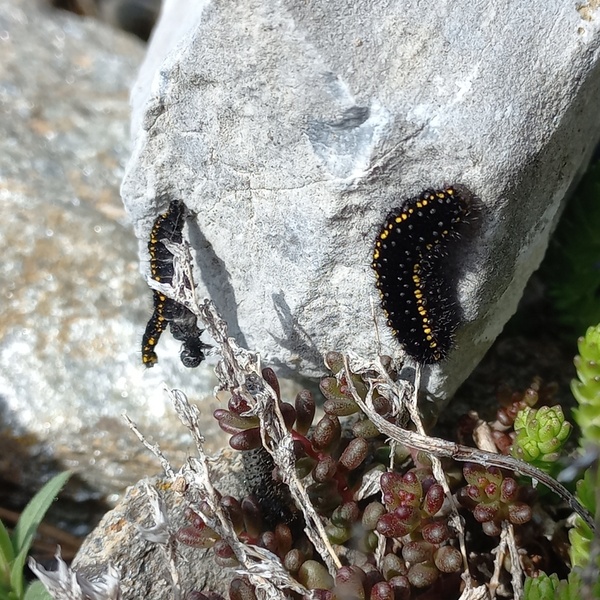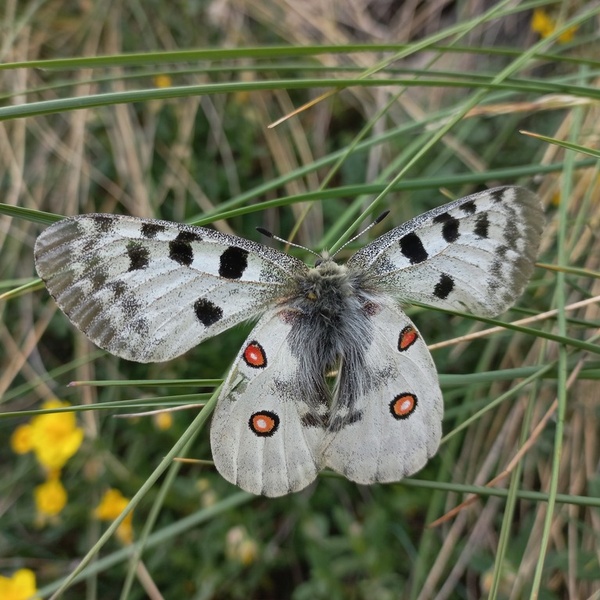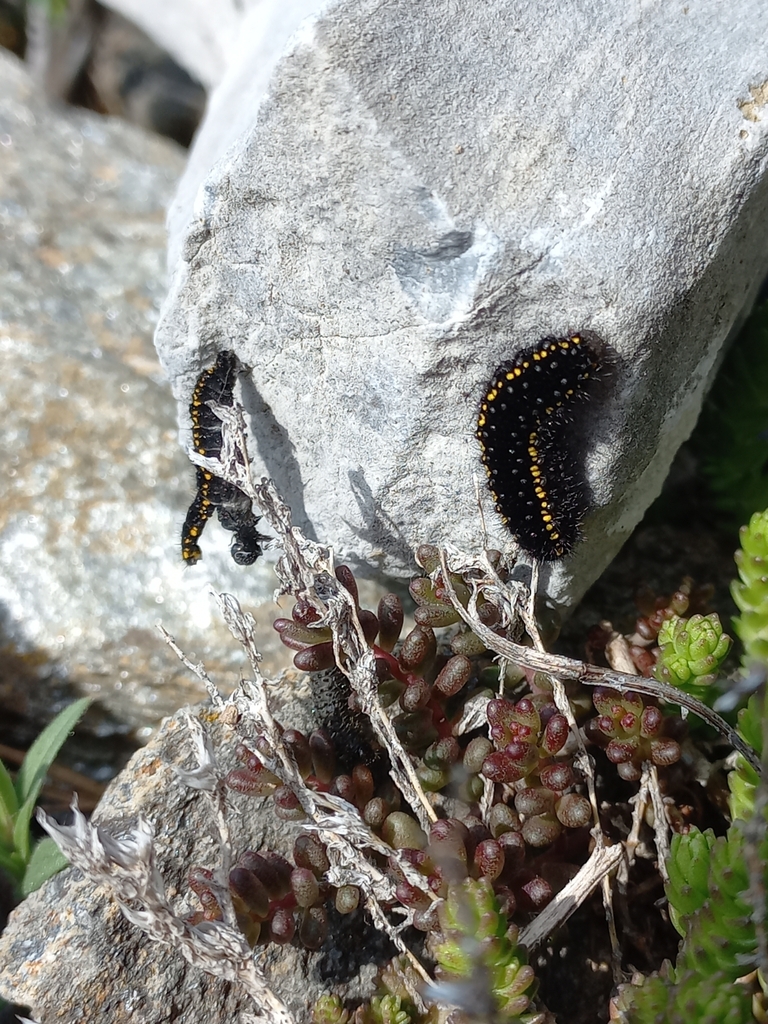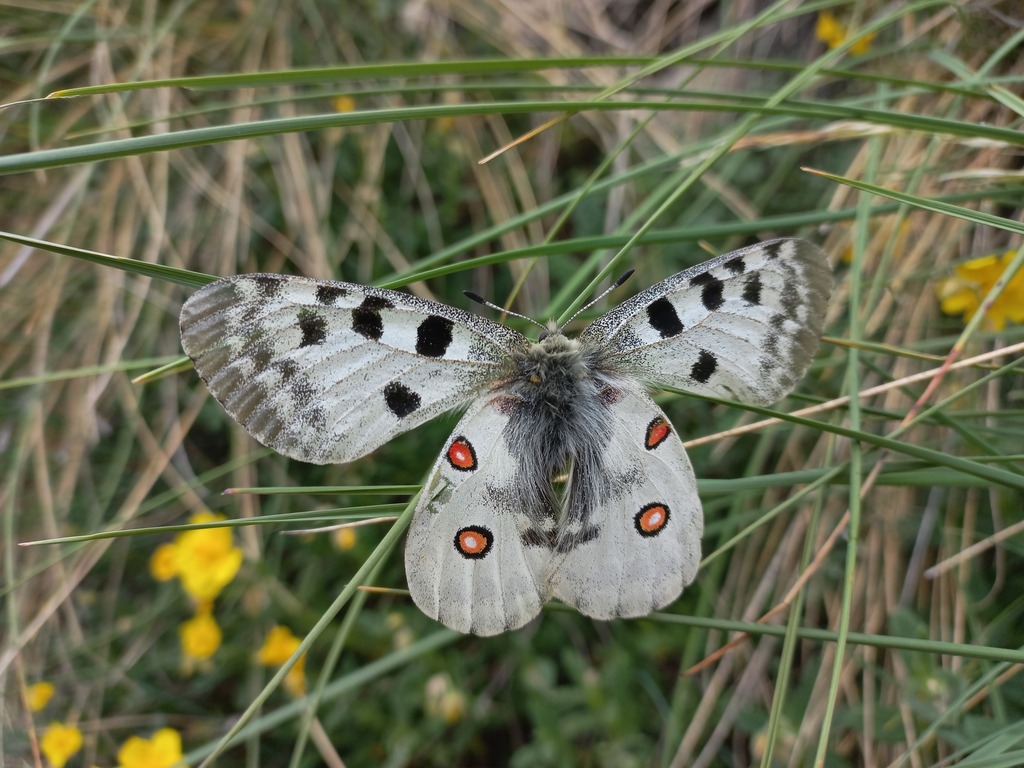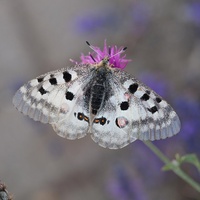
Classification:
Common name: Apollo
Kingdom: Animalia
Phylum: Arthropoda
Class: Insecta
Order: Lepidoptera
Family: Papilionidae
Genus: Parnassius
Scientific name: Parnassius apollo
Habitat:
Mountainous areas between 1400 and 2500 meters above sea level
Where can you find me?
Where can you find me?
Parco naturale Gran Bosco di Salbertrand
Parco naturale Orsiera Rocciavrè
Parco naturale Val Troncea
ZSC Bardonecchia Val Fredda
ZSC Champlas Colle del Sestriere
ZSC Cima Fournier e Lago Nero
ZSC Col Basset
ZSC Gran Bosco di Salbertrand
ZSC Les Arnauds Punta Quattro Sorelle
ZSC Oasi xerotermiche Val di Susa
ZSC Pendici del Monte Chaberton
ZSC Rocciamelone
ZSC Valle della Ripa
ZSC Valle Thuras
ZSC – ZPS Orsiera Rocciavrè
ZSC – ZPS Val Troncea
Classification:
Common name: Apollo
Kingdom: Animalia
Phylum: Arthropoda
Class: Insecta
Order: Lepidoptera
Family: Papilionidae
Genus: Parnassius
Scientific name: Parnassius apollo
Habitat:
Mountainous areas between 1400 and 2500 meters above sea level
The Apollo butterfly is a large diurnal lepidopteran with a wingspan that can exceed 5 cm. The wings are predominantly white with black spots in the anterior area, while they feature two or more red spots edged in black with a white pupil in the posterior area. Especially towards the end of the flight period, the tips of the forewings can become almost transparent due to wear. It is a glacial relic, meaning a species that extended its distribution to southern latitudes during the glacial periods and remained isolated in mountainous areas during subsequent periods characterized by a warmer climate. For this reason, its global population is now divided into numerous subspecies due to the isolation and fragmentation of its habitats. Apollo is one of the 3 species belonging to the genus Parnassius present in Italy (along with P. Phoebus and P. mnemosyne) and is found in the Alps only above 1000 meters in altitude, up to over 2500 meters above sea level. In the rest of Italy, it can also be observed on the peaks of the northern and central Apennines, in Aspromonte, in Sila, and in the Madonie in Sicily.
Biology
Apollo is a univoltine species, meaning it completes its life cycle in a single generation within the year, with the flight period of the adults usually between mid-June and early August. The mating of these butterflies has a peculiarity: right after copulation, the male secretes a colloid substance that quickly hardens, covering the female's genitals with a horny structure called sphragis thanks to a particular gland. This strategy aims to prevent mating with other males, ensuring the development of their offspring.
Once fertilized, the females lay eggs in rocky areas on warm and dry slopes, particularly choosing succulent plants of the genera Sedum and Sempervivum, which will represent the exclusive food of the larvae (the so-called "host plants"). In spring, the eggs hatch, and the larvae progressively grow to a length of about a couple of centimeters, assuming the typical black coloration with yellow spots. The pupation phase occurs on the ground in late spring, always near the host plants on which the larvae developed.
Starting from late May to early June, the emergence takes place, with the adult forms (true butterflies) beginning to flutter from flower to flower, preferably thistles, feeding on nectar and promoting pollination. The preferred habitat for this species for feeding is open meadows and alpine meadows where the blooms are more abundant. The Apollo butterfly produces a characteristic rustling sound with its wings during flight when alternating long glides with rapid wing beats.
Conservation Status
In the IUCN Red List, P. apollo is classified as Least Concern, meaning minimal risk, although its population trend is indicated as declining due to rising temperatures progressively eroding its habitats, especially in continental areas where the species cannot migrate to higher altitudes. In the Alpine territory and within the Protected Areas of the Cozie Alps, it can still be sighted quite easily because the species still generally enjoys a good health status, although in certain areas, the progressive abandonment of traditional mountain activities leads to a reduction in its preferred environments, such as treeless pastures and meadows.
In terms of protection, Apollo benefits from a long-standing tradition of conservation in Europe, probably due to the appreciation it has always enjoyed among collectors who had endangered its survival in the past. It is noted that in Germany, its capture was already prohibited in 1936. In more recent years, in 1977, P. apollo became the first lepidopteran placed under protection by CITES, the Convention on International Trade in Endangered Species of Wild Fauna and Flora. Following this, it was included among the species protected by the Bern Convention and the EU "Habitat" Directive.
Insights:
In the Protected Areas of the Cottian Alps, some populations of Apollo butterflies are monitored annually to control the species, as required by all EU Member States under the "Habitat" Directive.
Monitoring of Animal Biodiversity in Alpine Environment
https://www.parchialpicozie.it/it/progetti/2007/01/01/monitoraggio-della-biodiversita-animale-in-ambient/
The project monitors a series of animal groups, with the aim of identifying and documenting changes that may occur over time, as a result of global climate change. Among the species studied are also butterflies, including Parnassius apollo, one of the most important indicator species.
At the headquarters of Parco Naturale del Gran Bosco di Salbertrand, there is a butterfly garden, a habitat specifically created to host as many butterflies as possible, which can be admired during opening hours in the summer.
Microcosm
https://www.parchialpicozie.it/it/attivita/microcosmo/
This is an educational activity aimed at schools and organized groups dedicated to the fabulous world of insects, including the ethereal and marvelous butterflies.
You might also be interested in...
- campaign The thyme of the Cozie Alps Parks on Geo
- event The myths of the Butterflies
- event The myths of the Butterflies
- emoji_nature Cortippo di Conca Cialancia
- emoji_nature Formica rufa
- emoji_nature White partridge.
- emoji_nature Carabus cychroides
- emoji_nature Gravel bank
- book What do we do
- book Directives

 Fauna
Fauna
